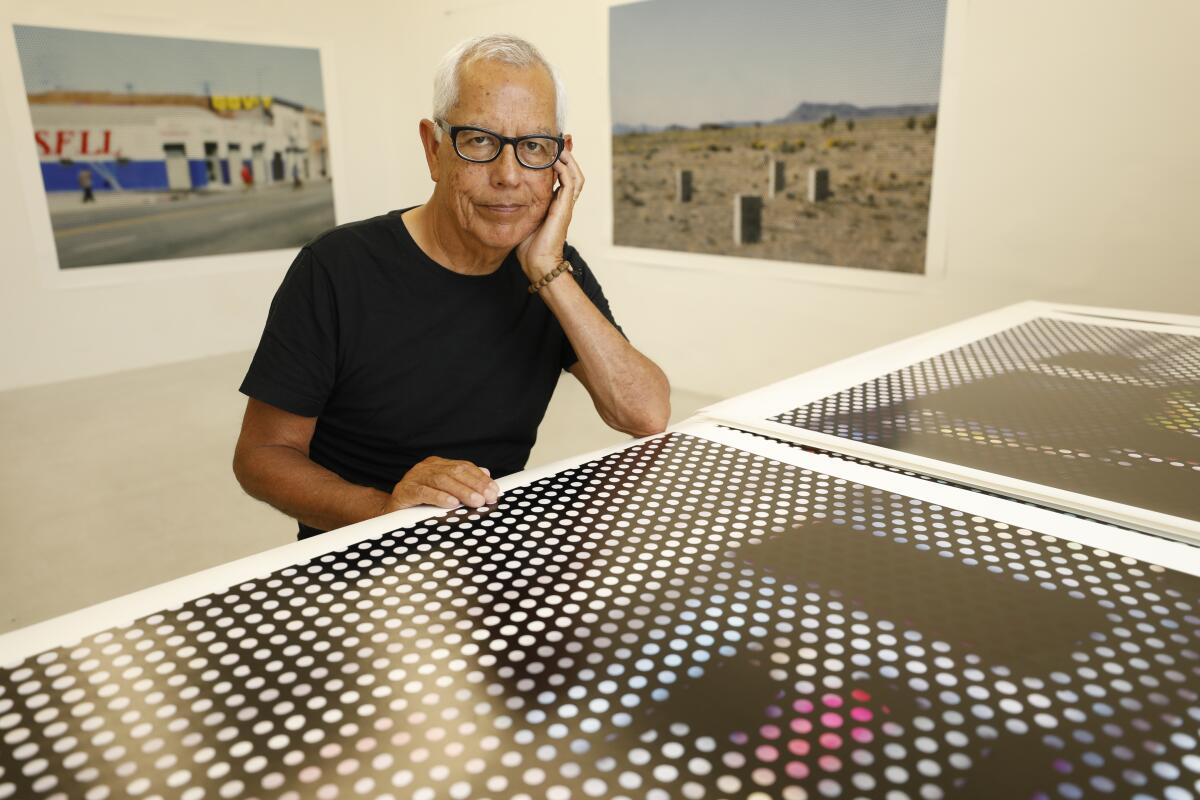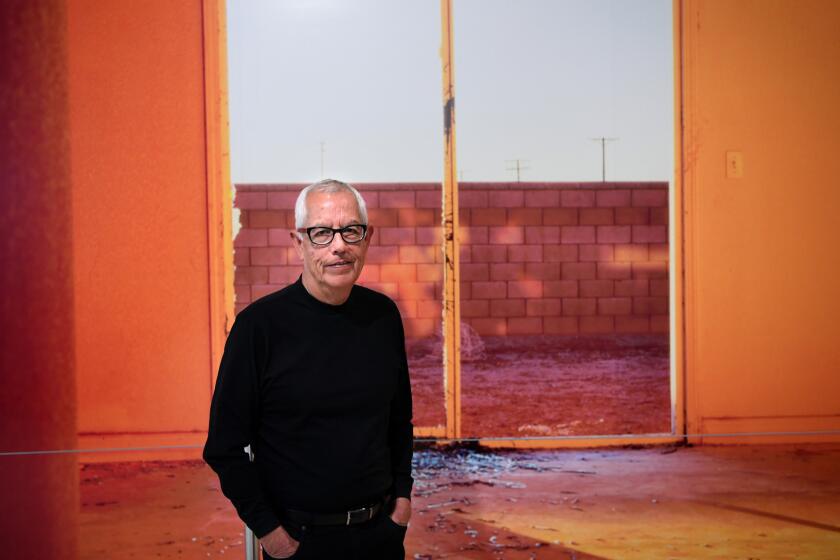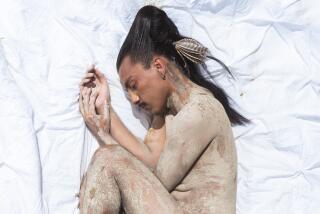Q&A: Anthony Hernandez’s L.A. photos are shown all over the world. L.A. museums need to catch up

For five decades, Anthony Hernandez, who was born and raised on L.A.’s Eastside — first in Boyle Heights, then East Los Angeles — has quietly chronicled the city’s rougher edges. His earliest experiments were with street photography, capturing Angelenos caught in private worlds as they moved around the city.
He soon graduated to rendering L.A. itself, hauling a large-format Deardorff camera around the city to record the grimy detail of junkyards and the hostile qualities of L.A. public space, including many bus stops, which appear and reappear in his work. Over time, he began to tackle the environments inhabited by the homeless, the so-called no man’s lands alongside freeways and railroad tracks that serve as a last resort for shelter.
For the record:
7:48 a.m. July 27, 2019A previous version of this article described a screen technique first popularized by artist Roy Lichtenstein as “Bendix dots.” They are “Benday dots.”
A city like L.A. is a lot of hard surfaces. It’s a hard place to be.
— Anthony Hernandez
Hernandez’s singular views of Los Angeles have, in recent years, drawn rising amounts of institutional attention.
In 2016, he was the subject of a retrospective at the San Francisco Museum of Modern Art. Last year, he was the recipient of a prestigious Guggenheim Fellowship.
In April, the Nelson-Atkins Museum in Kansas City debuted a survey of 40 photographs by the artist drawn from the museum’s permanent collection. One month later came the opening of the current Venice Biennale where Hernandez’s work is prominently featured in the two installations that make up the principal exhibition, “May You Live In Interesting Times,” organized by Los Angeles critic turned curator Ralph Rugoff (now director of London’s Hayward Gallery).
L.A. museums, however, have been slower on the uptake. Though Hernandez’s images reside in the collections of the Museum of Contemporary Art Los Angeles, the Hammer Museum, the Los Angeles County Museum of Art and the Getty Museum, his work has only been seen in group shows at these institutions. (He will be in another group show at the Getty in December: “Unseen: 35 Years of Collecting Photographs.”)
This month, Southern California audiences can see Hernandez’s work at his first solo gallery show in Los Angeles in more than a decade — at Kayne Griffin Corcoran, the gallery that now represents him.
They are images in which Los Angeles can see itself, the side that doesn’t make it onto the picture postcards: Broken-down trucks in wide empty lots, the improvised architecture of freeway-side homeless encampments and municipal spaces that seem to offer their residents little more than disdain.
The show features a recent series of images that the photographer took at L.A. bus stops, employing the shade screens that shelter these spaces as a filter through which to see the city. The screens, with their circular holes, obscure the landscape even as they reveal other aspects of it: glimmers of light, swathes of bold color, the unmistakable blue of a tarp covering a tent that serves as a makeshift home.
What these images make clear is that the Los Angeles of Anthony Hernandez is not the Los Angeles of sunny stereotype. It is the L.A. of gray and grit, of forlorn bus stops and rugged homeless encampments. A city that is growing more hostile to those who inhabit its fringes. Throughout his career, it is this unbecoming side of Los Angeles that has served as the photographer’s muse.
“I heard someone say the other day, ‘I don’t know what I’m going to do with L.A.,’” he says, seated amid large-scale photographic prints in his tidy Jefferson Park studio. “I loved that: What are we going to do with L.A.?”
What was the genesis of the bus stop images now on view at Kayne Griffin Corcoran?
In 1988, I was making pictures of close-up of screens and reflections through screens, so there have always been these layers that I was interested in. Then in 2003 or 2004, I bought a 500-mm lens for my Hasselblad. The only reason I bought it was because it was a really good deal. So I shot a couple of pictures through a bus stop screen with it. But I didn’t do anything with the transparencies until much later.
After my show closed at SFMOMA, I thought, what am I going to do? And I started thinking about these pictures and made these big prints of the pictures and that’s when it took off. Very quickly I made a lot of pictures [some are in Hernandez’s Giardini installation at the Venice Biennale]. The screen is in focus, everything else is out of focus — everything becomes more ambiguous and mysterious in a way.
You’ve made your own screen, similar to the ones on bus shelters, that you now use as a tool for taking pictures in other places.
An artist built it for me: Roy Thurston. He’s a really good painter. We went to a real bus stop, he measured the holes. He made a vertical screen and a horizontal screen. He made tripod legs from aluminum. With the screen, I can go anywhere. I’ve been going out and photographing a lot. It’s all L.A. — South Central, Watts, Compton. I have a picture I took on Melrose near La Cienega, near that store, Theory. There’s a row of mannequins there, but through the screen they look like ghosts. I’m so excited to have my printer start proofing them.
The screens evoke industrial printing — like the Benday dots you see in a Roy Lichtenstein canvas. Were you thinking about painting when you began to work on this series?
I was thinking of painting and drawing. But I always had the thought that I was using photography in a different way with the screens. This led into asking Roy Thurston to make me [the screen] and then I could, so to speak, paint and draw photographically.
The themes you’ve focused on during your career have become burning issues for Los Angeles as a city: public space, homelessness, inequity. What drew you to those topics?
A city like L.A. is a lot of hard surfaces. It’s a hard place to be. For me, walking around doing the bus stop pictures, it’s a way of tracking a city that nobody would be walking around in. Yet, when you look at the pictures, they are very animated. Those lunch hour spaces, it’s people trying to find a place to have privacy and eat lunch and it is very difficult and awkward. It’s trying to see parts of Los Angeles that nobody has seen.
You’ve said you are interested in capturing how people use Los Angeles. What uses to you see? And how have they changed over time?
If you are homeless, it’s changing. The homeless are being forced out of even sidewalks, forced into harder places. I have seen a lot of homeless people and they will have a little nook and it’s perfect. It might have been a doorway. But now there’s a fence and you can’t be in your doorway. You see all of these fences built on sidewalks. I’d say it’s even harder on the homeless than it was 10 years ago, 20 years ago. It’s so bad. All these years later, I’m still photographing the thread of homelessness.
This work takes you into some rough areas. Have you ever been threatened or mugged?
No. I did come close once. A lot of these places, there is nobody around. You could get killed and nobody would know. I went to this one spot. It was this live camp — people were there but not at the moment. I looked quickly to see if I wanted to make a picture and decided I didn’t. As I turned around to leave, I see this group of guys are coming my way. If I’d been there taking pictures and they’d come in, it could have been a bad moment. In a lot of places, people are on drugs. You can’t tell what you’ll run into.
But I do have an interesting story. I was out a couple of years ago — I had gone to this area many times to make a picture but had never made a picture. As I was walking out, I saw this guy walking in and he had a camera, a Leica. We bump into each other and chatted. He asks me what I’m taking pictures of. I said, “Fences.” He said, “I’m taking pictures of fences too.” He asks me my name and I told him. He says, “I just bought your book!” He was a young guy and he was like, “Do you mind if I take a picture of you?” So he took a picture of me.
What’s inspiring you about L.A. at this time?
My new screen. Now I have another tool and it gives me the freedom to try to photograph lots of different things. It means going back to a lot of the places that I tried to photograph before, didn’t photograph, but now I’m photographing with the screen. I made the picture one way; now I go back and look another way. I was born and raised in L.A. It became like my studio. I love the idea that L.A. is so rich, that I haven’t exhausted it. Because how can you exhaust L.A.?
“Anthony Hernandez: Screened Pictures”
Where: Kayne Griffin Corcoran, 1201 S. La Brea Ave., Mid-Wilshire, Los Angeles
When: Through Aug. 31
Info: kaynegriffincorocoran.com
More to Read
The biggest entertainment stories
Get our big stories about Hollywood, film, television, music, arts, culture and more right in your inbox as soon as they publish.
You may occasionally receive promotional content from the Los Angeles Times.












